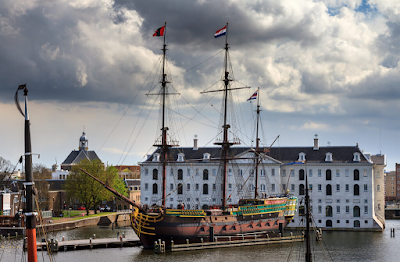The Dutch East India Company (VOC): Sailing Through Time, Shaping the World
Introduction
In the early 17th century, against the backdrop of the Dutch Golden Age, a maritime juggernaut emerged that would redefine the course of history—the Dutch East India Company, or VOC. Beyond its role as a trading entity, the VOC became a symbol of Dutch economic prowess, global exploration, and the birth of modern capitalism.
Historical Context
As Europe clamoured for dominance in global
trade, the Dutch Republic stood at the forefront. The formation of the VOC in
1602 was a strategic response to this fervour, marking the genesis of an
enterprise that would transcend the limitations of its time.
Global Trade and Colonial Expansion
The VOC's trade routes were the arteries of a
vast commercial network, connecting the Netherlands to the spice-rich East
Indies. The company's influence extended far beyond trade, as it laid the
foundations for Dutch colonies across Asia, Africa, and the Americas, reshaping
the geopolitical landscape.
Economic Impact
The VOC wasn't merely a trading company; it
was a harbinger of modern capitalism. The issuance of shares and innovative
business practices transformed the economic landscape, contributing to the
flourishing Dutch economy and establishing a blueprint for future multinational
corporations.
Controversies and Legacy
Yet, with prosperity came controversies. The
VOC's aggressive tactics and monopolistic practices stirred ethical debates
that continue to resonate. The company's dissolution in 1799 did not erase its
impact, leaving behind a legacy that sparks discussions on the consequences of
colonialism.
Cultural Exchange and Scientific Contributions
The VOC was more than a merchant fleet; it was
a vessel for cultural exchange. Dutch traders brought back not only spices but
also ideas, technologies, and scientific knowledge. The VOC-sponsored voyages
contributed to early mapping and botanical discoveries, fostering a cultural
and scientific renaissance.
Impact on Maritime History
The VOC's fleet, with its formidable ships and
skilled navigators, not only facilitated trade but also played a pivotal role
in shaping naval warfare and exploration. The VOC's legacy endures in maritime
advancements that echo through the annals of naval history.
Contemporary Perspectives
In today's globalized world, the VOC's impact
is still palpable. The Netherlands grapples with the complex legacy of its
colonial past, while former colonies reflect on the enduring consequences of
VOC rule. Ongoing discussions around reparations and historical accountability
highlight the far-reaching implications of the company's actions.
Conclusion
The Dutch East India Company, a symbol of
ambition and innovation, navigated uncharted waters and left an indelible mark
on the course of human history. Beyond spices and wealth, the VOC's legacy is a
complex tapestry of economic transformation, cultural exchange, and ethical
quandaries—a legacy that continues to shape our understanding of the
interconnected world we inhabit today. The VOC, though consigned to the pages
of history, sails through time, reminding us of the intricate interplay between
commerce, culture, and conscience.




Comments
Post a Comment